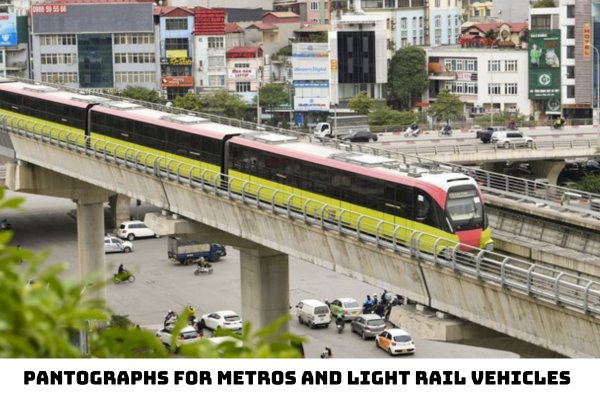What is Vietnam Standard TCVN 12701-2:2019 on Pantographs used for current acquisition from overhead power lines for metros and light rail vehicles about?
What are the technical requirements of pantographs in Vietnam?
Under Section 4 Vietnam Standard TCVN 12701-2:2019, the technical requirements of pantographs in Vietnam are clearly stated as follows:
(1) Limited gauge
The pantograph in the holding position and the operating position must conform to the limited gauge specified in the customer's technical regulations.
(2) The opening of the pantograph
Customer's technical regulations must clearly state the values related to parts from 3.2.10 to 3.2.13 in Table 1, Vietnam Standard TCVN 12701-2:2019, When there are no technical regulations in the documents on bidding, the horizontal deviation of the power intake stroke from the vertical axis in the entire working range must be consistent with Table 2 when the pantograph is obtained raise or lower.
Table 2 - Horizontal deviation of the power intake
Extensibility (mm) | The greatest horizontal deviation from the vertical axis (mm) |
E < 1 | 10 |
1 ≤ E < 2 | 20 |
E ≥ 2 | 30 |
(3) Electrical values
The supply voltages of traction power systems are specified in IEC 60850.
The technical regulation must also specify the duration and abnormal overvoltage values during the operation and holding of the pantograph.
The values defined in 3.3.1 to 3.3.3, Vietnam Standard TCVN 12701-2:2019 must be given in the customer's technical regulations.
(4) Static contact force tolerance
The static contact force tolerances measured during lifting and lowering must be within the limits defined in Appendix A, Vietnam Standard TCVN 12701-2:2019 unless a larger tolerance range is agreed upon between the user and the supplier.
(5) Horizontal rigidity
When transverse forces are applied to a part of the power intake support frame in the upper operating position, a deviation of 25 should not exceed the value specified in 6.6 and no permanent deformation appears.
(6) Power Intake
- Power intake profile
The customer's technical regulations must clearly state the values related to parts 3.2.6 to 3.2.8 in Table 1 and the external profile of the power intake.
- Contact strip
The strip material and/or contact strip design must be specified in the customer's technical regulations. In the absence of customer's technical regulations, IEC 62486 can be considered.
(7) Operating system
- General requirements
The operating system shall be designed so that in a stationary state and until the maximum speed of the traction device, any damage to the contact line will not cause permanent damage to the line or contact strip under normal operating conditions.
The operating system must be designed so that additional devices can be added that manual operation can be added in the event of a power failure.
- Electric motors
Under the environmental conditions considered in IEC 62498-1, electric motors must conform to the requirements in IEC 60077-1 and IEC 60077-2.
In case of lack of any special requirements in customer's technical regulations, electric motors must be protected to IP55 class in accordance with the requirements in IEC 60529.
(8) Automatic dropping device (ADD)
Pantographs must be equipped with automatic dropping devices only when required in customer technical regulations.
ADD must not cause further damage to the pantograph.
(9) Volume of pantograph and force on the hood
The supplier of pantographs shall specify the volume of the pantograph and appropriate tolerances with or without insulating parts. Any additional forces exerted by the system in a stationary state shall be determined by the Supplier.
(10) Protection against corrosion
Technical regulations regarding the application requirements and types of corrosion protection must be given in the technical instructions.

What are the type testing for pantographs in Vietnam?
Under subsection 6.1.2 of Section 6, Vietnam Standard TCVN 12701-2:2019, the type testing for pantographs in Vietnam is specified as follows:
- Vietnam Standard TCVN 12701-2:2019 distinguishes the basic model of pantographs from the referred model of the same type of pantographs. The cited model can integrate modifications to the basic design considered in existing type tests, provided that any of these changes can be demonstrated at least by the underlying design through calculations or operational experience.
- Type tests must be performed on a device sample of a given design.
- Consideration must be given to whether the current Supplier's device satisfies the type tests and is exempt from these tests if the Supplier produces confirmed reports of type tests that have been carried out on the same previously manufactured device.
- Additional type tests must be required if specified in the customer's technical regulations and after agreement with the Supplier.
What are the regulations on the factory, investigation and combination tests for pantographs in Vietnam?
Under Subsections 6.1.3, 6.1.4, 6.1.5 Section 6, Vietnam Standard TCVN 12701-2:2019, the factory, investigation and combination tests for pantographs in Vietnam are specified as follows:
Factory test:
Factory tests must be carried out to confirm the characteristics of the product corresponding to those acquired during type testing. Factory tests must be performed by the Supplier on each device. For certain device, after agreement between customer and supplier, factory tests can be replaced with sampling tests (tests performed on several randomly taken devices in the product batch).
Investigative test:
Investigative tests are special, complementary tests that are performed on a subject to gather additional information. These tests are required only if specified in the customer's technical regulations.
Combination test:
Combined tests are special and additional tests that can only be performed in an operating environment. These tests must take into account the type of vehicle used, its speed and the direction of travel. These tests must be carried out on roads and/or overhead power lines defined in the customer's technical regulations.
These tests apply to both basic and quoted models of pantographs.
These tests must be carried out if specified in the customer's technical regulations and after agreement with the Supplier.
LawNet